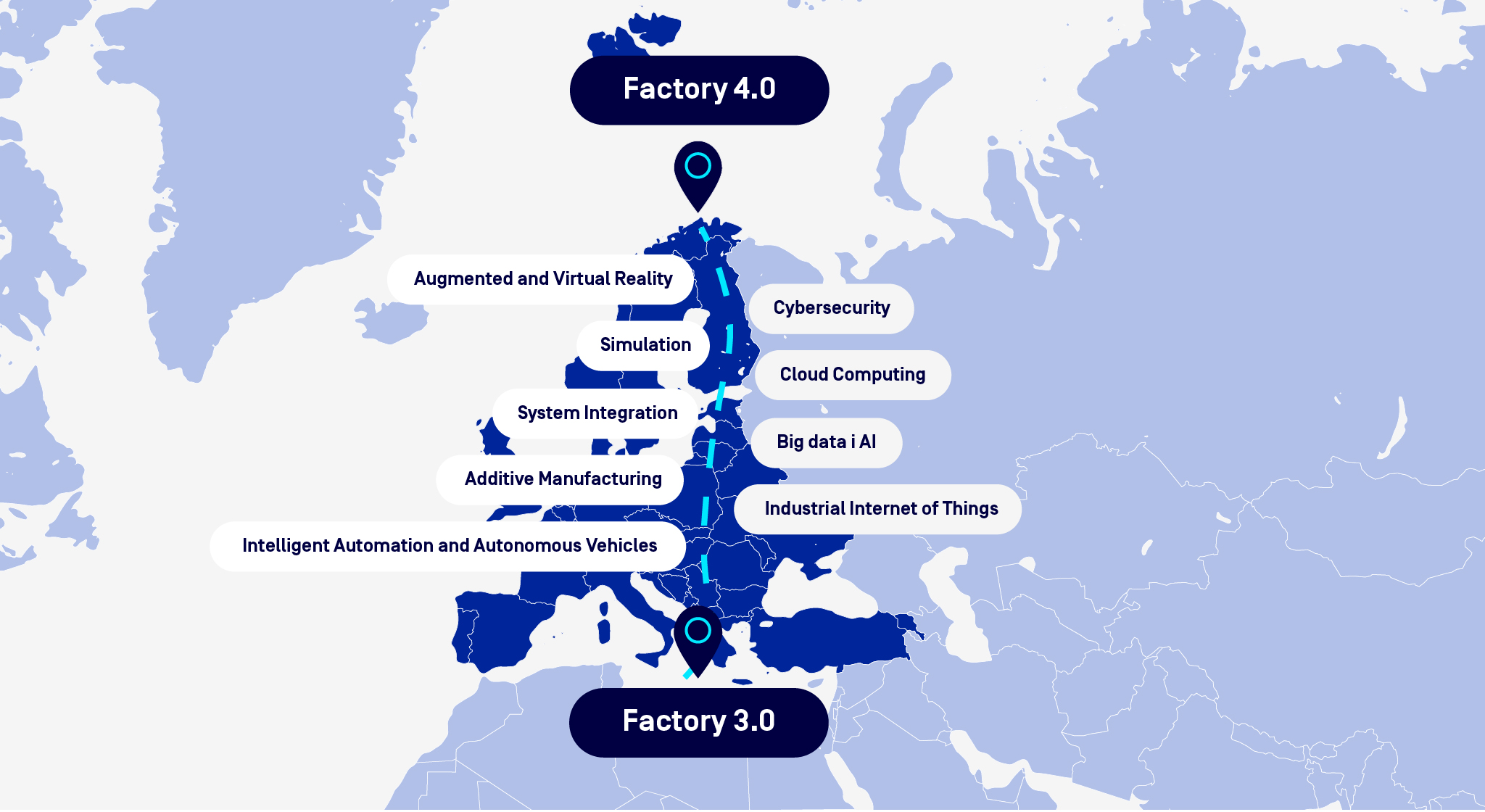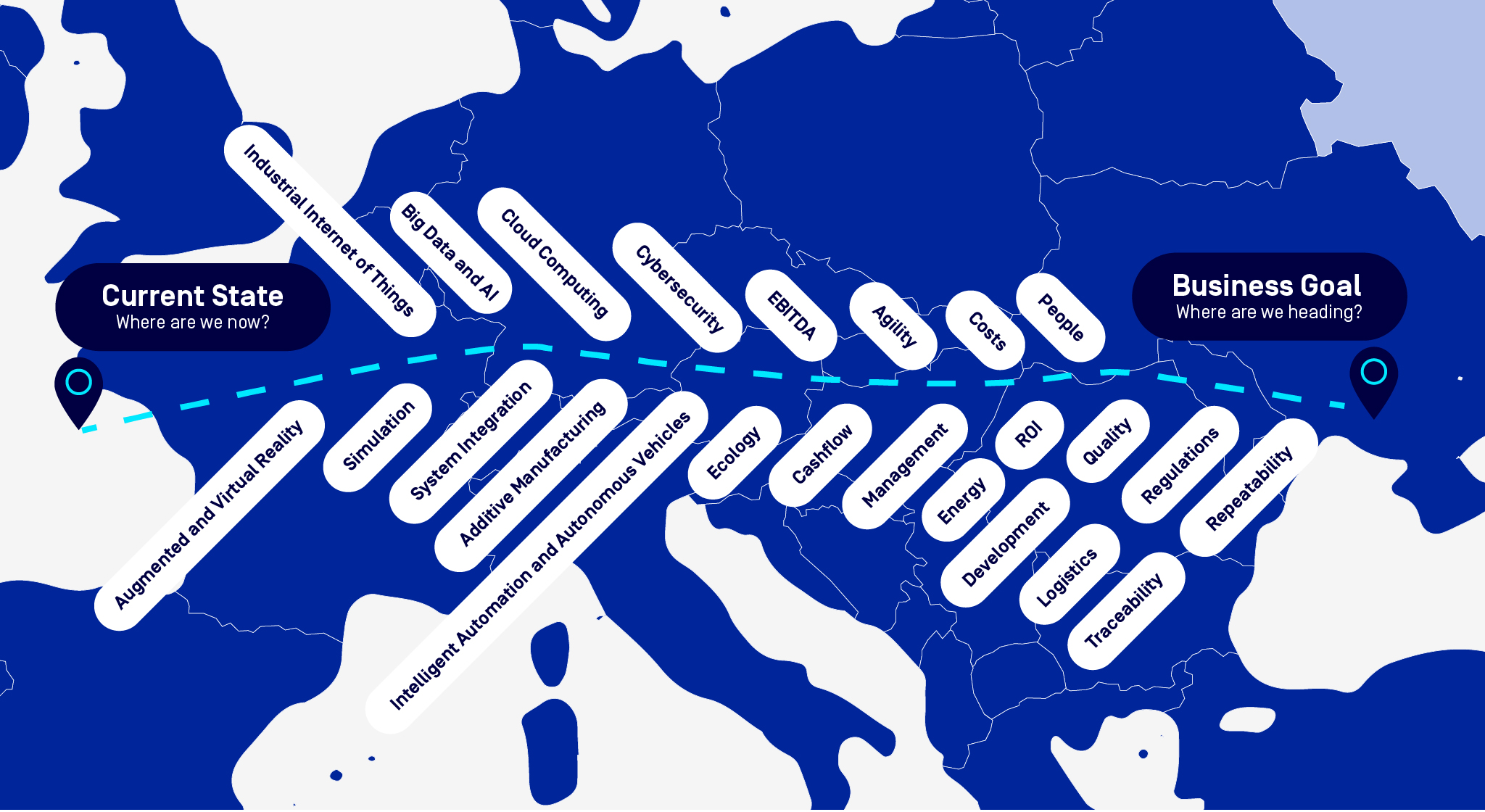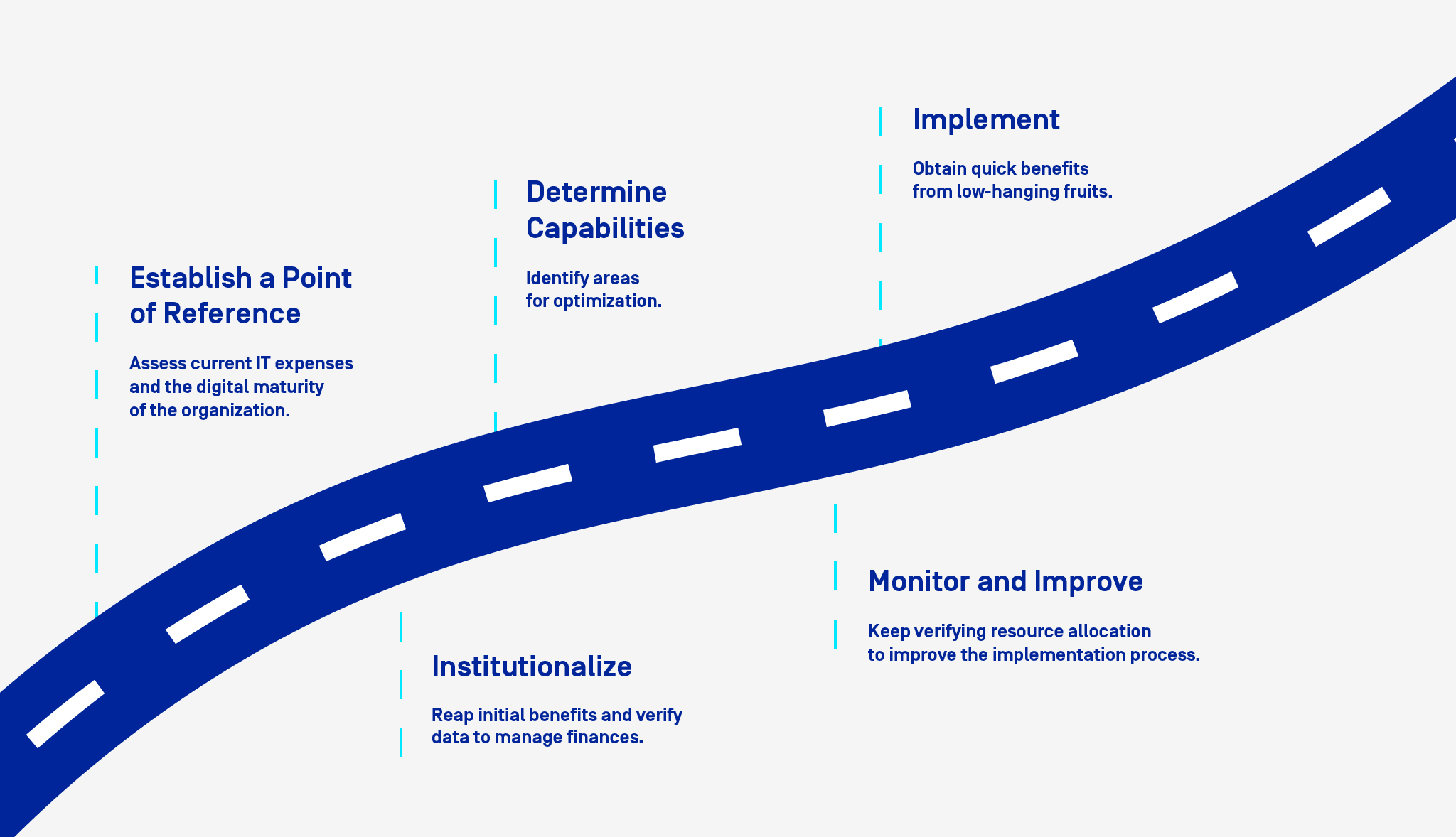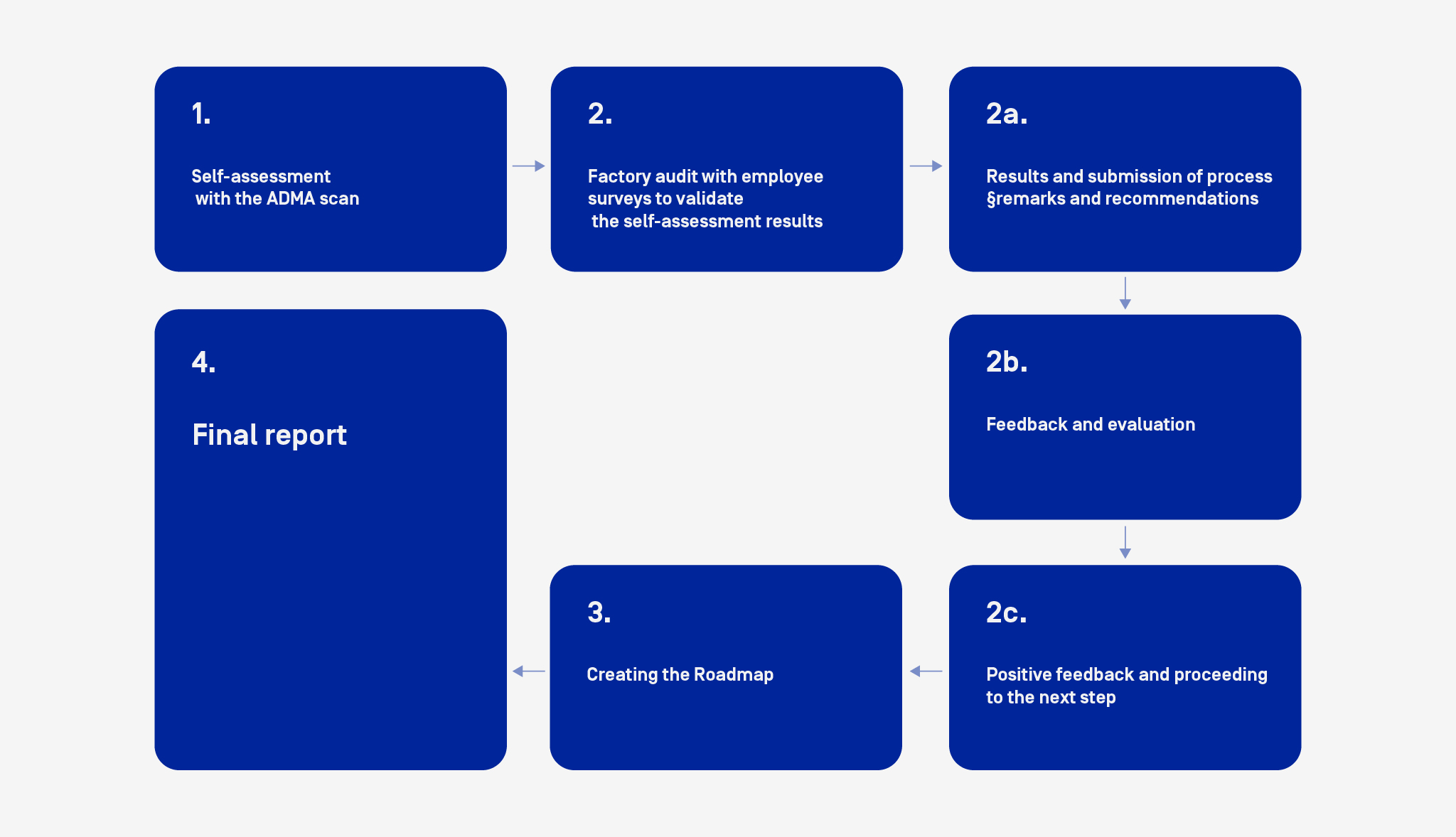
Factory Tailored to Industry 4.0: How to Reach It With the Digital Transformation Roadmap?
Let’s imagine that we want to transform our factory, currently at a 3.0 level, into a modern 4.0 facility. We know that Industry 4.0 is characterized by a set of technological solutions, so it might seem that the quickest path to this goal is to implement as many of these technologies as possible in your factory.

However, reality is not that simple. Achieving Digital Transformation requires understanding that it’s a complex process, with no single universal formula for success. So, where should we start? The best way is by asking some fundamental questions.
Each facility operates in its own unique way, whether it’s in organizing daily operations, processes, or development, etc. These factors depend on the company’s size, industry, workforce, management methods, and utilized tools. Sometimes, within the same company, several departments or production processes may exhibit a high level of digital maturity, while others require fundamental changes.
Therefore, we can’t simply say that the factory is at a level of 3.0, 3.2, or 3.5, as such terms would oversimplify the situation. Our current state needs to be diagnosed thoroughly, and then it will become clear that individual areas are at different levels.

Industry 4.0, the ideal that we strive for, doesn’t necessarily need to be the main objective itself. In practice, the primary focus is on the business goal. In fact, there might be several goals, some closer or farther from the Industry 4.0 vision, but all of them should be relevant to the company’s situation and bring tangible benefits.
At the beginning of your Digital Transformation journey, it is worth exploring what it entails and the benefits it offers. Learn more in our article:
Digital Transformation: What It Is and Why It’s Worth Pursuing
While Digital Transformation and its goals may differ from one company to another, implementing them is always a significant challenge. It’s essential to recognize that not everything can be achieved at once – many different actions, tools, technologies, time, and above all, committed people are required.
The Digital Transformation process is never linear. Along the way, various milestones will appear, with multiple paths to reach each one. This variety is a strength that offers numerous opportunities for development and learning. However, to avoid getting lost amid so many options, it’s useful to have a tool that helps you reach your goal in the best way possible for your company. This tool is the Digital Transformation Roadmap.
The Roadmap helps structure and organize subsequent actions. It shows where we currently stand, where we want to go, and what steps are needed to get there. Presenting individual initiatives on the Roadmap helps prioritize them and discover their interconnections.
Just as every company has its unique business goals, the Digital Transformation Roadmap must be individually created for each organization. It is advisable to seek the support of specialists who not only have expertise in creating these Roadmaps but can also provide an objective assessment of your company, identifying areas for improvement and solutions you may not have considered.
The action plan should first be developed at a general level. For the Roadmap, the initial step is to place certain road signs to ensure we are heading in the right direction.
Point of Reference
The first road sign establishes a point of reference – an analysis showing where we currently stand and what level of digital maturity our organization presents. At this stage, it’s also important to consider how our digital and IT-related expenses are financed.
Capabilities
After a thorough analysis of our current state, we can determine our capabilities and compare them with areas that require optimization, considering which of them – actions, processes, etc. – will be most beneficial and easiest to implement.
Implementation
The next road sign is the implementation stage. Here, we should focus on identifying the low-hanging fruits, which will deliver quick value. This can create a sense of purpose and value, while also helping to finance further initiatives.
Institutionalization
An essential step is using what we have already achieved. Monitoring and verification are key to ensuring that resources are still necessary in specific areas. If not, they can be reallocated to other areas, further advancing the transformation.

How should the Roadmap’s creation look? Now that we understand the key road signs that form its backbone, let’s explore the next steps to complete it effectively, ensuring it helps us reach our destination.
First, the company assesses its situation with an ADMA scan, a methodology created by the order of the European Commission to evaluate the digital maturity of organizations. It’s not only a guide on where the company stands on the path to Industry 4.0 but also a tool acknowledged by the European Commission and institutions responsible for awarding digitalization grants. This recognition can assist in securing additional funding for the company’s digital transformation.
In the next step, a factory audit takes place, which involves surveys with employees. Based on their observations, auditors confirm or question the results of the company’s self-assessment conducted in the first step. This process culminates in a sheet of remarks, offering observations, diagnoses, and suggestions for improvement.
Once all the information is collected, the next step is to analyze it together and establish the current state, considering both the company’s self-assessment and the auditors’ observations. It’s important to compare the evaluations and identify any discrepancies, clarify them and reach a consensus on the company’s present situation.

The final stage involves creating the Digital Transformation Roadmap, including any associated products and the preparation of a final report. Although this concludes the formal process, experts may offer further support, such as developing a plan for the first initiatives or creating technical specifications. It is a helpful option, but we should be aware that implementing all initiatives will take time and not everything can be done simultaneously.
What are the key benefits of developing a Digital Transformation Roadmap?

- Coherent Development Strategy and Clear Goals: The foundation of the Roadmap is setting a primary goal and its business justification, giving the company a clear direction. The individual initiatives included in the Roadmap are designed to support this overarching goal.
- Predictable Investment Plan for Future Years: The initiatives in the Roadmap aren’t random. Each one is carefully planned, showing how it connects to others and how it can be evaluated in terms of time, cost, and impact on the organization. This allows the company to group the initiatives into stages, helping to estimate the overall time frame for each phase and enabling efficient financial planning.
- Coordinated Development Across All Areas: By selecting specific areas for auditing, we ensure that each of them is taken care of, and no crucial area is overlooked. The Roadmap highlights interconnections between different areas, facilitating a coordinated approach to development.
- Thoughtful and Planned Spending: As each initiative aligns with business goals, it is justified and leads to measurable benefits. This prevents wasting resources on meaningless activities and ensures that all expenditures are well-considered.
- Benefits at Each Stage of Implementation: The Roadmap includes milestones that not only bring us closer to the primary goal but also achieve smaller goals along the way, delivering significant benefits at each stage.
The Digital Transformation Roadmap answers key questions: Where are we now? Where do we aim to be? What is our overarching business goal, and what steps will take us there? Why do we strive for Digital Transformation?
Answering these questions helps establish a clear business justification and aligns the Roadmap with the company’s strategic goals. This is essential because no transformation project is worthwhile without a clear justification.
Careful and thoughtful approach to the development of the Digital Transformation Roadmap ensures success on the path to becoming the Factory of the Future.

Michał Zieliński is a graduate in Automatic Control and Robotics, as well as a postgraduate Lean Six Sigma Black Belt from Gdansk University of Technology. He is a partner at ImFactory, where he works as a Project Manager and Head of the Digital Consulting Department. At ImFactory, he is involved in shaping a vision for the advancement of IT systems in manufacturing environments, evaluating the digital maturity of enterprises, and planning their Digital Transformation journey. His projects encompass a wide range of activities, from overseeing surveillance and monitoring installations to implementing comprehensive integrated manufacturing management systems.
See also
Want to learn more? Visit our Knowledge Base, where you'll find articles and webinars by experts to expand your knowledge.
Check if Digital Transformation is the Answer to Your Company's Needs


































